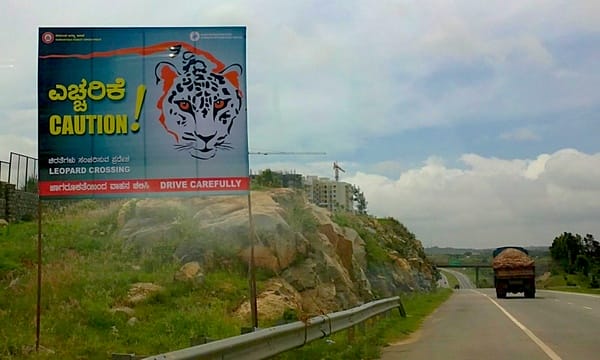The recent incident at Vibgyor school, Marathahalli in Bengaluru, involving the rescue of a leopard which had strayed into the school premises, has once again brought up the topic of man-animal conflict in urban areas. The rescue mission which lasted ten hours, was traumatic for both the animal in question, as well as the several men who were injured during the course of the rescue. While the animal was captured and moved to a rescue centre, there are rumours floating around of other leopard sightings in Nallurahalli and nearby areas.

A sign cautioning drivers about leopards crossing the road. Pic: Mani Kaushik, Wikimedia Commons
The education dept had announced a holiday today for schools in Marathahalli, Varthur, Immadihalli, Doddakannelli zones; however, some schools were working. Here are some useful things to keep in mind, especially for people living in in the peripheral areas near wildlife habitats.
‘Go indoors if you spot a wild animal’
Vidya Athreya, an ecologist who has been working specifically on the man-leopard conflict in Sanjay Gandhi National Park (SGNP) in Mumbai says, “We’ve been working in Bombay where there are many people, and there are many leopards. In the case of leopards especially, they are shy animals and try to avoid contact with humans as much as possible. The situation in Vibgyor got out of hand only because there were so many people around, because of which the leopard panicked.”
She cites an incident from the 1980s in Nepal, where a biologist captured on camera, a leopard that he had collared, straying into a cattle shed at night. In the morning, people went about their business without knowing that the leopard was in their vicinity. When night fell again, the leopard slunk away, without anyone knowing about it. She also talks about instances in India where farmers water their crops standing at the edge of their field, not knowing that a leopard is resting on the very same field, not more than 20 metres away.
Regarding what a person should do on sighting a wild animal within city limits, she says, “There are two things – 1) Gather your family and friends and go indoors, and 2) Once you are indoors, inform the police as well as the Forest Department. From here, provided the Forest Department and the police are equipped to handle the situation, they will take care of it.”
Dos and don’ts to minimise conflict with wild animals
Wild animals do not recognise boundaries. However, they do their best to avoid contact with people. The following precautions taken from the Mumbaikars for SGNP website and other resources can help prevent casualties in the event of a conflict.
If you spot a wild animal within city limits, ensure you are in a safe area and alert the authorities.
-
Deputy Conservator of Forests, Bengaluru Urban
Dipika Bajpai – 94819 60885
dipikabajpai48@gmail.com
@dipika_bajpai -
Call your local police station
Citizen Matters called the Bannerghatta Rescue Centre to check if they would respond to calls for wildlife rescue. The veterinary doctor we spoke to stated that citizens would need to call BBMP, and that BRC could not respond unless they received orders from the Executive Director (080 2782 8300/ 2782 8540, 91649 50099). She also added, “Maybe after this incident they might create a separate help line like 100 or 108 for wildlife as well.”
-
Recognise that merely sighting a wild animal within city limits does not translate to danger.
-
Alert the Forest Department and the local police.
-
Do not try to trap the leopard on your own. Leave it to the experts.
-
Be alert once it is dark. Ensure children are supervised if they are outdoors.
-
Do not move alone after its dark. Always walk with company. This alerts the animal and reduces the chances of the animal mistaking you for a prey.
-
If you find yourself alone, you could perhaps play loud music on your phone. You could also carry a torch and a stick for protection. This too will let the animal know that you are not prey.
-
Avoid walking through a thick, vegetated area once it is dark.
-
If you have dogs at home, avoid walking the pet once it is late.
-
If a wild animal is sighted, stay calm and give it right of way and allow it to move away peacefully. In most cases, the animal will leave on its own.
A poster on the dos and don’ts of living with leopards. Pic: mumbaikarsforsgnp.com. Click on the image to enlarge picture
During a rescue attempt, the animal feels cornered and is already stressed out. Crowds and the noise only add to its panic. It is natural for the animal to want to defend itself, when all it really wants to do is get out of the situation.
In an 2013 interview with Wall Street Journal, wildlife researcher and conservationist, Krishna Tiwari says, “Don’t form a crowd around a leopard. Don’t scream at it or attack it. The last thing you want to do is frighten a cornered leopard, because it will make it much more likely to injure someone in a desperate bid to escape.”
Maruthi (name changed), a conservationist who has been involved in several animal rescues in and around the Mudumalai area, says, “During a wildlife rescue, the curiosity of the crowd makes the rescue attempt a very risky affair. What the crowd should understand is that the rescue team’s agenda is twofold – 1) to ensure that the animal is rescued without putting its life at risk; 2) to ensure that there are no human casualties. While it is natural for people to be curious and want to see a leopard, and possibly capture it on camera, the crowd only hinders the rescue process.”
‘A specialised rescue team is the need of the hour’
Man-animal conflict is likely to rise as a result of the dwindling forest cover, especially in areas that border forests. With respect to how a wildlife rescue needs to be carried out, Maruthi says that in case of a situation like at Vibgyor, the police should follow due process like they would at a terrorist attack, and evacuate the area of people. In addition, the area must be cordoned off to contain the animal in the area.
To ensure that the casualties are kept to a minimum – whether animal or human, Maruthi says that a specialised rescue team is the need of the hour. “Right now, people with functional knowledge of the particular animal’s behaviour are called in for the rescue, since there aren’t enough trained people around; so even researchers and scientists who have limited experience of dealing with live wild animals are asked to come. It is like asking a doctor to go argue in court. Someone who is studying animal scat or researching is not equipped to handle a field rescue. They should ideally be roped in as consultants who are not expected to carry out the rescue themselves. We shouldn’t be in a position where every rescue is like a suicide mission for those called to help in.”
Maruthi says the Specialised Rescue Team should ideally consist of people who have experience in handling live animals in the past, forest guards, a veterinary doctor who takes a call on whether a tranquilizer should be used based on the health of the animal, etc, and the team needs to headed by someone who is no less than an Assistant Conservator of Forests. He points out, “In addition to merely providing the team with the relevant protective gear – helmets, arm gear, jackets, etc, the team needs to be trained to handle situations like this.”
He adds, “What is really lacking in wildlife rescue missions across India are standard operating procedures (SOP). While they are protocols that need to be followed, they are not followed. These SOPs give directions on what should be done – area to be evacuated, Section 144 of IPC to be enforced, Forest Dept to be called, vet to be on duty.”
Lessons from Mumbai for Bengaluru
The manner in which the man-animal conflict in SGNP, Mumbai is countered could probably be the way forward for Bengaluru to handle such incidences going forward.
Vidya says, “At SGNP, over time, we have worked out a system which looks out for the best interests of the people as well as the animals. We have given workshops to the police on how they need to dissipate crowds at the time of an emergency. We involved local NGOs and interested citizens to help people understand what they should do. People now know that they need not panic, or give in to knee-jerk reactions. We have also interacted with the media to put out information about how people should react.”
Vidya also talks about why media should exercise constraint at a time like this. She says, “The media has to be responsible about the way they report these situations. There is no point in creating panic among citizens. Instead, give people information on what they should do; write articles that actually benefit people.”
Garbage begets creatures from the wild
A very important aspect in managing man-animal conflict that is typically ignored is garbage, one of Bengaluru’s favourite pet peeves! Specific attention needs to be given to garbage dumps as well, especially in areas that are in close proximity to wildlife. Garbage dumps typically attract stray dogs, and this in turn, attracts the wild animals looking for prey. This is also perhaps a sign for residents of Bengaluru and the BBMP to follow waste segregation and disposal norms!
Related Articles

Good article, but to read the “A poster on the dos and don’ts of living with leopards”, you need a powerful set of magnifying lens.
You can click on the picture. It will open a pdf file which you can magnify.
Thank you for the useful information! Kindly share the number of the forest department helpline too.
What to do if you (really) see a wild animal within Bengaluru city limits
1. Print this article.
‘@Adithya, Dipika Bajpai, the DCF has said that folks can contact her for confirmed sightings. Her no, twitter handle and email ID are listed above.